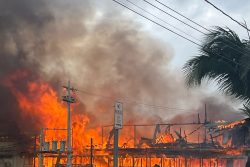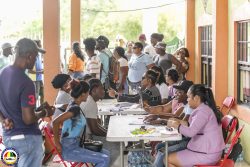The Ministry of Agriculture has issued an advisory banning all poultry and poultry products from the Dominican Republic following a recent outbreak of the generic form of Avian Influenza in that country.
The advisory in the form of an advertisement, which was for all poultry importers, was published in the Kaieteur News yesterday. Those advertisements are not being placed in Stabroek News since the cut-off of state advertising in November 2006. In Friday’s edition, Stabroek News had reported that Antigua had imposed a ban on poultry from the Dominican Republic following the outbreak. It is unclear whether Guyana has been importing any type of poultry product from the Dominican Republic which shares the island of Hispaniola with Haiti.
Minister of Health Dr Leslie Ramsammy yesterday noted that this is the closest the disease popularly known as bird flu has come to Guyana. He said the ban was the right position for Guyana to take since the issue is an emerging one in the Dominican Republic and until the extent of the outbreak is known Guyana should not take any chances.
Dominican Republic health officials recently culled 115 chickens which tested positive for avian flu in an effort to contain the virus, its government said last week Thursday.
The rare outbreak in the town of Higuey was discovered last month when fighting roosters awaiting export to Colombia were tested and found to carry the H5N2 strain of avian flu, government livestock director Angel Faxas was reported as saying.
H5N2 is not a danger to humans, but has produced outbreaks across Asia and prompted the culling of more than five million birds in Japan alone since 2005. The more virulent H5N1 strain has infected humans, killing more than 120 people in Asia.
Speaking to Stabroek News, Dr Ramsammy said Guyanese have nothing to be afraid of but cautioned that there is always need for concern especially because of the fact that the outbreak is so close to home. He said that things have been in place in Guyana to deal with any such outbreak and one of the priorities is early detection of the disease. He said there is not much Guyana can do to prevent the disease from entering the country. What is important, the minister said is the early detection of the disease should it enter the country and that is what his ministry and other stakeholders have been working on in recent times.
“We have to sit down and decide that if it does come to this country we detect it early rather than late. We have to ensure that we do all that is humanly possible to detect it early and that is what we have been doing,” the minister said. He said surveillance is ever constant as they are looking for dead birds around the country and systems are in place to test these birds immediately.
Last year August the ministry held an exercise to simulate an outbreak of bird flu at Laluni, Soesdyke/Linden Highway and the minister had said based on that exercise the country is prepared should there be such an occurrence.
Dr Ramsammy at that time had said he was confident that Guyana would be able to adequately contain the situation had there been a real outbreak. “A number of weaknesses were identified and we will be working on this to further boost our systems in preparing for a real situation,” the minister had said at the time.
The five-hour exercise was carried out with the collaboration of several agencies, including the health and agriculture ministries and the Pan American Health Organisation. A detailed report indicating the areas that needed to be strengthened was expected to be compiled and released while measures to address identified weaknesses were to be developed. (Oluatoyin Alleyne)









